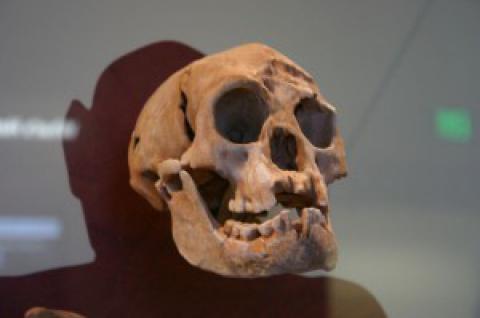18,000 years ago, the remote Indonesian island of Flores was home to a population of tiny humans. They stood only about 3.5 feet tall on their large feet, and their skulls housed unusually small brains approximately the size of a grapefruit. The identity of these ‘hobbits’ has been hotly debated for years: Were they modern humans suffering a disease, or a new species, Homo floresiensis?
Biological anthropologist Karen Baab first studied a model of LB1, the only skull recovered from the site, at the American Museum of Natural History in 2005. In a recently published PLOS ONE study, she and other researchers compare this specimen to a range of other modern human and extinct hominin skulls to get closer to settling the identity of Homo floresiensis, or ‘Flores man’.
The origins of ‘Flores man’ have been debated for quite a while now. What are the possible origins that are being discussed, and why the uncertainty?
The primary debate has centered on whether LB1 (and possibly the other individuals found on Flores) represents a new species that descended from an extinct species of the genus Homo or whether it is instead a pathological modern Homo sapiens, i.e the same species as us. If the Flores remains do in fact represent a distinct species, then the next question is whether they descended from Homo erectus, a species that may be our direct ancestor, or an even more primitive species. The latter scenario implies an otherwise undocumented migration out of Africa.
What makes it so hard to settle the argument one way or the other?
One of the difficulties in settling this particular argument is that most studies have focused on one or the other of these ideas and compared the Flores remains to either fossil hominins or to pathological modern humans, each using a different set of features. This makes it challenging to compare the alternative hypotheses side-by-side.
What kind of diseases might have caused modern humans to have features similar to these ‘hobbits’?
The three that have been discussed most prominently (and the three we looked at) are microcephaly, endemic hypothyroidism (“cretinism”) and Laron Syndrome. Microcephaly is not a disease per se, but rather a symptom of many different disorders. It refers to having an abnormally small brain and therefore skull. “Cretins” suffer from a lack of thyroid hormone before and after birth, which leads to stunted growth and possibly a slight decrease in skull size. Laron Syndrome individuals produce growth hormone, but their bodies do not properly recognize it, again leading to stunted growth and other developmental issues.
Only a few specimens of this hominin have been found, and there’s only one known skull, from the specimen named LB1. Are there reasons why these specimens have not been discovered elsewhere?
If Homo floresiensis descended from Homo erectus, then their closest relative lived just “next door” on the nearby island of Java. In this case, the unique features of the Homo floresiensis species probably evolved in the isolated island environment of Flores. If, however, the ancestor was a more primitive species, and Homo floresiensis didn’t branch off from H.erectus, it is possible that they might have migrated earlier than known, and we could still find older sites in mainland Asia containing this ancestral species.

You compared the morphology of the LB1 skull to many hominin ancestors and modern human populations from around the world. What were some of the most striking similarities and differences?
The LB1 skull is very distinct from the typical modern human’s, as it has a lower, more elongated silhouette when viewed from the side, , greater width at the rear of the braincase, and a flatter frontal bone (the bone underlying the forehead) with a more pronounced brow ridge. Interestingly, these are some of the same features that distinguish archaic species like Homo erectus from modern humans.
Specimens of Laron Syndrome and “cretin” skulls from modern Homo sapiens presented large, round, globular braincases, which are very different from the smaller, lower and less rounded braincase of LB1. The microcephalic human skulls present a closer comparison to LB1, but still show clear distinctions from LB1 in much the same way that they differ from species like Homo erectus or Homo habilis.
Overall, the LB1 braincase is most similar in shape to small-brained Homo erectus from Eurasia that are 1.8 million years old.
How does this analysis add to, or change, what we knew about Flores man?
This analysis provides a unique opportunity to evaluate these evolutionary and pathological hypotheses side-by-side based on the same criterion – of cranial shape similarity. The results support a stronger affiliation of LB1 with fossil Homo than with any of the proposed pathologies. This study also offers an improvement over previous assessments of the microcephaly hypothesis by using a more extensive sample that better captures the variability in this disorder.
Do these results conclusively settle the discussion? What other possibilities still exist for the origins of H. floresiensis?
While very little in paleoanthropology is ever “settled,” I do think this study represents an important step forward in terms of putting the pathological hypotheses to rest. The question that remains to be answered definitively is which species of archaic Homo is the most likely ancestor of Homo floresiensis – Homo erectus or an earlier and more primitive species of Homo?
Citation: Baab KL, McNulty KP, Harvati K (2013) Homo floresiensis Contextualized: A Geometric Morphometric Comparative Analysis of Fossil and Pathological Human Samples. PLoS ONE 8(7): e69119. doi:10.1371/journal.pone.0069119
Images: Homo floresiensis by Ryan Somma, Cave where the remains of Homo Floresiensis where discovered in 2003, Liang Bua, Flores, Indonesia by Rosino


Spread the word